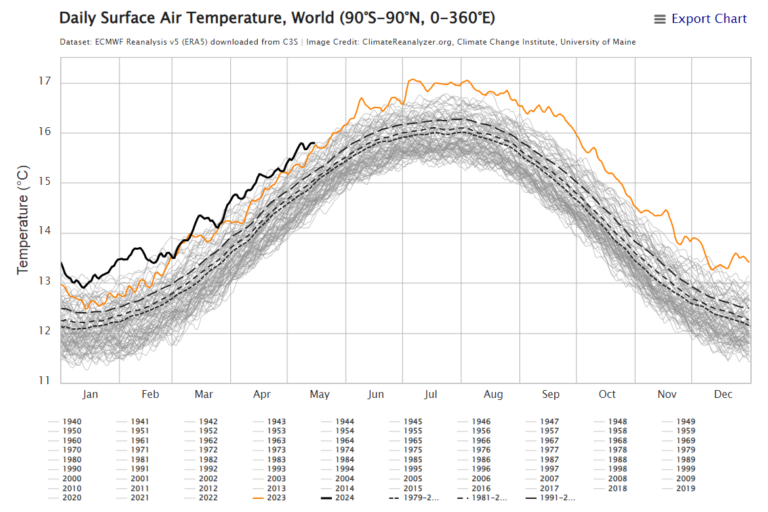

사라진 19년, ‘1.5도’ 파리협약 지난해 근접
정책자들 기후법정에 세워야
19년이 사라져 버렸다. 기후 역사에서 인류가 이룬 최대의 성과인 파리 기후협약이 내다본 예상치에서 무려 19년을 앞당겨 1.5도에 도달했을 것이라는 우려가 나오고 있다. 2015년 195개국이 모였던 유엔기후변화 당사국 총회(COP21)는 탄소배출을 감축해서 산업화 이전에 비해 지구 평균기온을 2045년에 1.5도, 2050년엔 2도 상승까지 막자는 야심찬 계획에 합의했었다. 이를 위해서는 2030년까지 탄소 배출을 43% 감축하기로 결의했었다.
그런데2023년에 그 1.5도 한계치에 거의 도달해 버렸다. 파리 기후협정은 일반 고속도로의 제한 속도로 달리는 자동차가 되기로 약속했으나 실제 지구기온 상승은 독일의 아우토반을 시속 300킬로미터로 질주하는 것처럼 달려왔다. 기후 정책 결정권자들의 이런 행동은 운전자라면 벌금 정도가 아니라 운전면허가 박탈돼야 할 정도지만 75억명을 태우고 달리는 지구촌 어느 국가도 그들을 법정에 세우지 못했다.
몇 달 전에도 나눴던 이 그래프는 1940년 이후 매일의 지구 평균기온을 그래프에 나타낸 것이다. (참조 https://climatereanalyzer.org/clim/t2_daily/?dm_id=world) 가는 선들은 해마다의 평균 기온이다. 중간의 점선들 중 맨 위 점선이1991년부터 2020년까지 평균이고 그 아래 점선은 1980년부터 2010년까지 평균이다. 3개 점선 중 아래선은 1979년부터 2000년까지 평균이다. 서로 중복되게 평균을 낸 이유를 ‘과알못(과학을 알지 못하는)’ 일반인으로 정확히 알 수는 없지만 점점 높아지는 것은 확실하다. 그리고 주황색 선은 바로 2023년이다. 6월 이후 사상 최고로 높은 온도로 치솟기 시작해 12월 말까지 거의 대부분 기간이 기록적이다. 다른 해는 2016년이 비교적 평균기온이 높았던 해였다고는 하나 그래프는 다른 해와 교차되는 경우가 많았지만 지난해는 무려 7개월이 다른 해와 비교할 수 없을 만큼 높았고 그 추세는 2024년 1월에도 이어지고 있다. 지난해가 과연 1.5도를 돌파 했는지에 대한 과학적 연구는 나오지 않았으나 적어도 그에 매우 근접해 있을 가능성이 높다는 예측이 우세하다.
물론 지구 전체 평균 기온이니 앞으로 몇 년 간은 엎치락뒤치락 하며 상승하락을 반복하겠지만 적어도 과학자들은 이제 2045년 대신 2035년엔 거의 확실히 1.5도를 돌파할 것으로 보고 있다. 그런데 지금까지 지구의 온도 상승은 과학자들의 예상 범위 구간에서 늘 최악의 상황에 가깝게 가고 있다. 작년의 기온은 2030년 전후에 나타날 것으로 예상됐지만 7년이나 앞당겨 진 것이다. 지구는 지금 과학자들의 예측 속도 중 가장 높은 속도로 달리는 중이다.
이와 함께 지구촌 탄소 농도 역시 꾸준히 직선을 그리며 높아지고 있다. 파리 기후협약을 직전부터 보여주는 탄소농도 그래프는 둔화되거나 꺾일 조짐이 보이지 않는다. 이 그래프에는 세계 평균 이산화탄소 농도(검은 선)와 미국 하와이의 마우나 로아 섬에서 관측한 데이터(빨간 점선), 그리고 미국과 남극 등 다른 지역에서 측정한 데이터가 모여 있다. 이들 수치를 평균한 까만 직선이 곧게 위를 향해 달려가고 있다. 그도 그럴 것이 공기 중에 한번 배출된 이산화탄소는 사라지지 않는데 인류는 해마다 더 많이 배출해 왔다. 최근 증가 추세만 줄었지 배출량은 여전히 늘어나고 있어 전체 농도는 줄어들 수 없다. 2015년만 해도 400ppm 이하였고 산업혁명 이전에는 250ppm 근처였으나 지난해는 420 ppm을 넘었다. 계절별로 굴곡이 있는 것은 자연의 이산화탄소 흡수양이 달라지기 때문이다. 가을에 작물을 수확하면 광합성을 하는 식물이 줄어들어 이산화탄소가 늘어나고 봄이 되어 경작지에 식물이 자라면서 광합성도 증가, 탄소 농도가 약간 줄어드는 사이클이 해마다 반복된다. 만약 농경지를 일년 내내 광합성을 계속하는 식물이나 나무로 채운다면 탄소는 급격히 줄어들겠지만 우리는 소고기를 먹어야 하고 쌀과 밀을 주식으로 하는 인구가 많기 때문에 겨울에도 광합성을 하는 나무로 경작지를 채울 수도 없는 것이다. 인류가 직면한 최대의 도전을 풀어가기 위해서 과감히 정책결정권자들을 기후 법정에 세워 그 면허를 박탈해야 한다. 깨어 있는 기후시민이 함께 행동해야 한다.
정필립(토론토 생태희망연대)
Lost 19 Years, Paris Agreement’s ‘1.5°C’ Target Approached Last Year
Policymakers Should Be Held Accountable in ‘Climate Courts’
Nineteen years gone. There are concerns that the Paris Agreement, the greatest human achievement in climate history, may have missed the mark by a whopping 19 years, putting us on track to reach 1.5 degrees. In 2015, the 195-nation United Nations Conference of the Parties (COP21) agreed to an ambitious plan to reduce carbon emissions to keep the global average temperature rise to 1.5 degrees Celsius by 2045 and 2 degrees Celsius by 2050 compared to pre-industrial times. To do this, they had committed to a 43% reduction in carbon emissions by 2030.
By 2023, the 1.5-degree limit was nearly reached. The Paris Agreement promised to be like a car driving the speed limit on a regular highway, but in reality, global warming has been racing down the German Autobahn at 300 kilometers per hour. The behavior of climate policymakers is the sort of thing that a driver should be fined for, but no country in the world with 7.5 billion people on board has taken them to court.
This graph, which I shared a few months ago, plots the average global temperature for each day since 1940 (see https://climatereanalyzer.org/clim/t2_daily/?dm_id=world). The thin lines are the average temperature for each year. The top dotted line in the middle is the average from 1991 to 2020, and the bottom dotted line is the average from 1980 to 2010. The bottom of the three dashed lines is the average from 1979 to 2000. The reason for the overlapping averages is unclear to the ‘unscientific’ layperson, but it’s clear that they’re getting higher. And the orange line is the year 2023. It starts to soar to record high temperatures after June, and is a record for most of the year until the end of December. The other year, 2016, was a relatively average temperature year, but the graph often overlaps with other years, but last year had seven months of unusually high temperatures, and that trend is continuing into January 2024. There are no scientific studies on whether we actually hit 1.5 degrees last year, but the consensus is that we are likely to be very close to it.
Of course, this is the average temperature for the entire planet, so it will continue to rise and fall over the next few years, but at least scientists now believe we will almost certainly hit 1.5 degrees by 2035 instead of 2045. But so far, global warming has always been on the worst end of the range of scientists’ projections. Last year’s temperatures were expected to occur around 2030, but that’s seven years early. The planet is now running at the highest rate scientists have ever predicted.
At the same time, global carbon concentrations have been rising in a steady, straight line. This graph of carbon concentrations from just before the Paris climate agreement shows no signs of slowing down or breaking. It plots the world’s average carbon dioxide concentration (black line), data from observations at Mauna Loa, Hawaii (red dotted line), and measurements from other locations, including the United States and Antarctica. The black line, which is the average of these numbers, is running straight up. That’s because once it’s in the air, carbon dioxide doesn’t disappear, and humans have been putting more into the atmosphere every year. Only the recent increase has slowed, but emissions are still rising, so the overall concentration is not decreasing. In 2015, it was below 400 parts per million, and before the Industrial Revolution it was around 250 parts per million, but last year it was over 420 ppm. The seasonal variation is due to nature’s differential uptake of carbon dioxide. When crops are harvested in the fall, fewer plants are photosynthesizing, resulting in more carbon dioxide, and then in the spring, as plants grow on the fields, photosynthesis increases, carbon concentrations decrease slightly, and the cycle repeats every year. If cropland were filled with plants or trees that continue to photosynthesize year-round, carbon would be drastically reduced, but we can’t fill it with trees that photosynthesize in the winter because we need to eat beef and we have a large population that eats rice and wheat. To solve the greatest challenge humanity has ever faced, we must boldly put policymakers in the climate court and take away their license. Awake climate citizens must act together.
By Philip Jung (HNET)
(AI translated)
